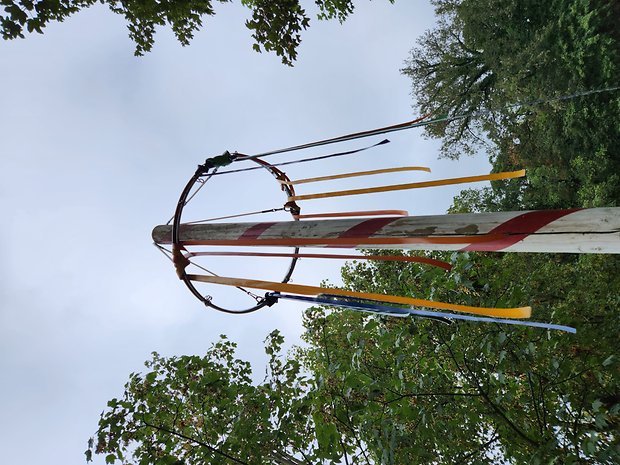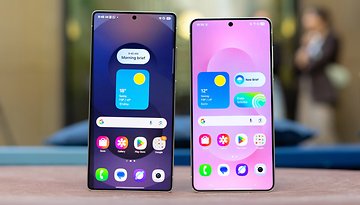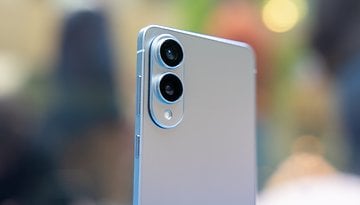Galaxy Z Fold 4 vs. Z Fold 3: Samsung's butterflies compared


Read in other languages:
Samsung launched the Galaxy Z Fold 4 in August 2022, the successor to its best foldable yet. The update of the Z Fold 3 becomes even more robust in the process, featuring more powerful cameras and offers a higher degree of performance. In our comparison of the two smartphones, you can find out whether an upgrade is worth your time and money and which model should new customers pick up if they want to jump aboard the foldable bandwagon.
| 2022 model | 2021 model | |
|---|---|---|
| Product | ||
| Image |  |

|
| Dimensions & weight open |
|
|
| Dimensions closed |
|
|
| Display main |
|
|
| Display secondary |
|
|
| SoC |
|
|
| Memory |
|
|
| Software |
|
|
| Rear camera |
|
|
| Front camera |
|
|
| Battery |
|
|
| Connectivity |
|
|
| IP certification |
|
|
| Colors |
|
|
| Price (RRP on release day) |
|
|
| Rating |
|
|
| To the offer* |
On August 10 at 9AM ET, Samsung released the Galaxy Z Fold 4 and Galaxy Z Flip 4 models as part of its Unpacked event. In addition, there was the Galaxy Watch 5 and the Galaxy Buds 2 Pro. In this article, however, we want to zero in on the Z Fold 4 and compare the powerful foldable to its predecessor.
Jump to:
- Display and casing
- Performance and connectivity
- Cameras
- Software
- Battery and Quick Charging
- Price and availability
- Conclusion
Galaxy Z Fold 4 vs. Z Fold 3: Display and case
To distinguish the new Galaxy Z Fold 4 from its predecessor, it is best to simply put the phones on top of each other. The new model has become minimally smaller with the same display size. The weight has also been reduced from 271 grams to 263 grams. However, both figures will not really be noticeable in everyday use. The differences that you can see in the table are too small for that.

There is nothing new to report about the displays. When opened, you still benefit from a brilliant 7.6-inch AMOLED display with a smooth refresh rate of up to 120 hertz. To save energy, this can be adjusted down to 1 hertz. This is only possible up to 48 hertz for the outer display. The outer screen still measures 6.2 inches.
What Samsung has improved even more is the smartphone's robustness. Although the water resistance is still only certified according to IPX8, more resistant glass is used. The outer casing of the Z Fold 4 is made of Gorilla Glass Victus+, while the inside is made of Ultra-Thin-Glass, which is supposed to be 20% more scratch-resistant. Good news for the durability of the phone. as Antoine attested to in his review.

Galaxy Z Fold 4 vs. Z Fold 3: Performance and connectivity
While the storage configurations of Samsung's most expensive foldable have remained the same with 12 gigabytes of RAM and 256 or 512 gigabytes of internal storage, a new heart beats in the Z Fold 4. As expected, it is the Qualcomm Snapdragon 8+ Gen 1, which is manufactured in the modern 4-nanometer process and is currently the most powerful processor for Android phones.
| Samsung Galaxy Z Fold 4 | Samsung Galaxy Z Fold 3 | |
|---|---|---|
| 3D Mark Wild Life | 8,611 | 5,683 |
| 3D Mark Wild Life Stress Test | Best Loop: 10,332 Worst Loop: 5,606 |
Best Loop: 5,579 Worst Loop: 3,435 |
| Geekbench 5 | Single: 1,332 Multi: 3,947 |
Single: 1,095 Multi: 3,239 |
Both 3D Mark's benchmark test and Geekbench 5 made it clear that the performance has improved significantly compared to the Galaxy Z Fold 3. At the same time, you will have fewer problems with overheating or thermal throttling in the Z Fold 4.

The connectivity has remained the same: There is 5G, LTE, Wi-Fi 6E as well as Bluetooth 5.2. In short, the Z Fold 4 has become faster and should handle multitasking as well as mobile games even better. However, the new hardware is not a must-have.
Galaxy Z Fold 4 vs. Z Fold 3: Cameras
More exciting is the new camera of the Galaxy Z Fold 4. I chose the singular here on purpose—because Samsung only replaced the wide-angle camera on the back. It now has a sensor with 50 megapixels, which is again optically image-stabilized and behind the same f/1.8 lens. The pixel size shrinks as a result. However, Samsung could improve the quality thanks to pixel binning.

Otherwise, the camera setup is the same. Ultra-wide-angle pictures are taken with 12 megapixels, and the same is true for telephoto. However, the telephoto lens now offers an optical 3x zoom, which is a significant improvement. One of the front cameras is located under the display, has a resolution of four megapixels and is covered by a coarse pixel layer.
Samsung has improved the hiding game a bit, but the sensor is still clearly visible especially against a white background. Cool, but not quite as magical as in the Redmagic 7 Pro! What should be of your greater concern is how the photo quality of this snapper is below average.
Ultimately, however, it is the pictures that speak for themselves and show you just what is possible with the cameras of the Galaxy Z Fold 3 and Galaxy Z Fold 4. Therefore, you can take a look at our galleries here. First, the test photos we took with the Galaxy Z Fold 3:
Galaxy Z Fold 4 vs. Z Fold 3: Software
With Android 12L, Samsung switches to the specialized tablet version of Android for the software. As expected, you get OneUI 4.1.1 that is based on Android 12. You can read more about Samsung's skin in the detailed One UI 4.0 review. You can use a new start bar and extended multitasking functions for more productivity with exclusive foldable features.
There is good news regarding the display. In the review, Antoine discovered that the Z Fold 4 had no problems with the user interface display when gaming. This was still an issue with the Galaxy Z Fold 3 under select use cases. However, there are still apps that cause problems or display black bars, such as when you fire up Netflix and YouTube.
The guarantee of software updates is Samsung-typical breathtaking. You'll get four major Android updates and five years of security updates. Since the Z Fold 4 is newer, you'll also get a year longer of updates—but that's just due to time.
Galaxy Z Fold 4 vs. Z Fold 3: Battery and Quick Charging
There is still disillusionment when it comes to quick charging. While the Huawei Mate Xs 2, which I recently tested, charges with 67 watts despite the foldable display, Samsung still only charges with 25 watts. The battery capacity of 4,400 milliampere hours has also remained the same. Nevertheless, the battery runtime has improved slightly compared to last year's foldable. Wireless charging and wireless reverse charging are also supported!
What remains annoying and rather disappointing for a $1,799 smartphone is how Samsung continues to exclude a charger in the box.
Galaxy Z Fold 4 vs. Z Fold 3: Price and availability
Samsung's Galaxy Z Fold 4 appeared in stores on August 26 in Grey Green, Beige, and Phantom Black color variants. You will pay $1,799 for the cheapest 256 GB variant, with the 512 GB available for $1,919, and you can also grab the 1 TB version only for a whopping $2,159. Only the 512 GB version has seen a change in price. In comparison, the Galaxy Z Fold 3 with 256 GB storage can already be found for $1,199.99 on Amazon.
Conclusion
Never change a running system or lack of innovation - depending on your allegiance, you will probably find one or the other statement appropriate. The fact is that Samsung has improved the Galaxy Z Fold 3 in a sensible manner, even if the differences seem marginal at first glance.
Thanks to the powerful Snapdragon chipset, the new foldable has noticeably juice underneath the hood, while photography fans will also be happy about the improved main camera and the 3x optical zoom in the telephoto lens. Overall, the device is more robustly manufactured and even the identically sized battery lasts longer.
So if you read this comparison on the display of the Galaxy Z Fold 3, you won't need to invest a small car price in a new phone again. However, if you want to enter the world of foldables, buying the Z Fold 4 is clearly recommended. This is mainly due to the performance advantage and the better future-proofing, which is especially relevant for expensive smartphones.
And now, over to you: What is your opinion about Samsung's update of its foldable series? Does it make sense or could the manufacturer have saved the Z Fold 4? Share with us in the comments!
























































